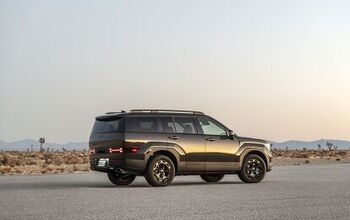2010 Volkswagen GTI: First Drive

It’s been a long time since Volkswagen launched the original GTI back in 1974 and a lot has changed. Over the years VW has continually refined the car with better materials, more power, improved safety and a higher curb weight. As a result, the feeling of driving a GTI has changed considerably. But lets be honest here, there’s no sense comparing this car to the original as the GTI hasn’t delivered that incredibly raw driving sensation for at least a decade.
Get the Flash Player to see this player.
FAST FACTS
| 1. The 2010 GTI is powered by VW’s 2.0 TFSI engine with 200hp and 207 ft-lbs of torque. |
| 2. DSG models hit 60 mph in 6.7 seconds and get 24/32 mpg (city/hwy), while six-seed manual models run 6.8 seconds with a 21/31 mpg rating. |
| 3. Notable new features for 2010 include a 6.5-inch touch-screen audio system and an electronic limited slip differential. |
And while it’s hard not to have a soft spot for low power, light weight little hatchbacks, replacing the feeling of a corner-carving tin can with a corner-carving refined ride has its benefits. And importantly, throughout this evolutionary process, Volkswagen has stayed true to building an affordable vehicle that’s also a genuine driver’s car.
ALL NEW FOR 2010?
For 2010 Volkswagen is launching the all-new GTI, which we just had the opportunity to test out on the scenic and roads of Georgia. Whether or not this new model is “all-new,” however, is debatable.
As a result of the overwhelmingly positive reviews that the previous generation (Mark V) model received, VW decided to follow the “if it ain’t broke” approach, choosing instead to tweak the fifth generation vehicle and sell it as the sixth.
The chassis has been retained, although the suspension differs slightly with stiffer springs and a 2mm thicker rear sway bar.
The engine is also a carry over, but it’s impossible to complain as the 2.0-liter turbocharged four-cylinder is undeniably one of the best powerplants on the market. There’s 200hp at 5100 rpm and 207 ft-lbs of torque from 1800 rpm to 5000 rpm.
Outside, the design is unmistakably GTI and while the changes are mild, they make a big difference in transforming the car. Gone is the old jellybean body in favor of a more serious performance design. Particularly impressive are the new, more angular headlights, the large front opening and the red-trimmed grille, which most certainly harkens all the way back to the car that started it all.
Out back, VW also decided to outfit the car with a sporty dual exhaust system, with one pipe at each side. As a result the GTI is now instantly recognizable from either the font or the back.
On our test models, we did note the design carry-over on the “Detroit” wheels, a design we didn’t like when we first it on a Lamborghini Countach and don’t like now. Thankfully Volkswagen does offer several other styles.
What we very much do like for 2010 are the improvements made to the car’s interior – although the HVAC controls do still feel a bit flimsy. Inside, it’s far more premium than you’d expect in a compact car – especially when you consider the starting price is $23,290. Notable features include a 6.5-inch touch screen audio system, a thick flat-bottomed three-spoke steering wheel with aluminum accenting and red stitching. There’s also red stitching on the shift boot and e-brake handle. And, of course, there’s VW’s trademark “Interlagos” plaid seats, which come with some supportive side bolstering and have three-stage heat. Or, opt for the Autobahn package with a sunroof and even more highly bolstered leather seats, which feature the letters “GTI” embossed on the headrests.
ON THE ROAD: FAST AND FUEL EFFICIENT
We had the chance to drive two different models from either end of the price spectrum: a six-speed manual two-door model, as well as a four-door DSG-equipped model with the optional Autobahn package and the Navigation system, which is an all-new and much more user friendly unit brought over from the Audi A5. Interestingly, VW says that 60 percent of GTIs sold are two doors, while the split between the manual and DSG transmission is almost a perfect 50/50.
First up was the four-door DSG model, which we thoroughly enjoyed. The dual-clutch automatic gearbox can be operated using the paddle shifters or with the shift stick in the center console. Optionally, just leave it in auto mode (or the more aggressive Sport mode) and let the computer do the work. And even if you forget, the car will automatically upshift in manual mode at about 7000 rpm – which can be an annoying feature if you plan to take your GTI to the track.
Shifts are lighting fast. This is no tiptronic auto-box. Those not familiar DSG certainly need to give it a try. More and more cars will be using similar systems in the near future with the Audi/VW-pioneered DSG setup having recently been adapted by both Porsche and Ferrari.
With the DSG box, the GTI hits 60 mph in 6.7 seconds – a tenth of a second faster than the manual. It’s even more fuel-efficient with a rating of 24/32 mpg (city/highway) compared to 21/31 for the manual.
Acceleration from a stop is impressive, but once at highway speeds the pulling power is diminished. That’s expected though as the GTI is still a reasonably priced hot hatch and not a sports car. It’s actually amazing how quickly it does accelerate considering 200hp is a pretty modest output by modern standards.
Like any VW, the car is at home on anything that resembles an autobahn, feeling extremely well planted at speed and making 80 mph feel like 50.
CARVING THE CORNERS
On the twisty country roads near Road Atlanta, our GTI testers handled flawlessly. The thick steering wheel gives incredible control with the optional 18-inch high-performance summer tires (and the car) reacting instantaneously to every input. There’s more than enough power to spin those front tires from a stop, but once you’re going, they grip incredibly well. At speed they just refuse to screech, even with the ESP off. In fact, the most we heard out of them was a whistle.
Much of this has to do with the GTI’s new XDS electronic limited slip differential. It works by using the brakes to slow the inside tire to prevent it from spinning, instead of using a heavy mechanical setup. And the weight savings helps, as the new GTI is roughly 50 lbs lighter than the outgoing model.
This system can also be credited for practically eliminating both understeer and torque steer – the latter of which is still plentiful at low speeds with the ESP off.
Corner after corner, the car gripped and was amazingly good at laying down the power right from the apex, having me wish I was driving on Road Atlanta and not to it. Body roll is minimal and we have to hand it to the VW engineers who built such a serious apex machine without the jarringly stiff ride. The seats offer plenty of lateral support and the big front brakes do a great job – although they do feel rather spongy. The same can be said of the gas pedal, which isn’t overly responsive.
With an extremely refined, comfortable and quiet drive, it’s really such a shame that the pedals aren’t more sensitive. Sure it makes the car more useable as a daily driver, but it dulls the driver’s sensation of being in sync with the engine. The setup in the Honda Civic Si (one of the GTI’s main competitors) is far better.
The same can be said of the manual transmission.
As a card-carrying member of the manual-transmissions-are-best club, we can’t believe we’re saying this, but we honestly preferred the DSG setup, even at an $1,100 premium. The problem with the GTI’s manual tranny is that the shift throws are too long, as is the clutch pedal, which has so much travel you feel the need to point your toes just to reach the firewall.
But worry not driving enthusiasts; with all the refinements that make up the 2010 GTI, Volkswagen’s engineers deemed it necessary to dial in a few extra decibels of driving enjoyment. With improvements in sound deadening, the noise of the engine is so muffled that the new GTI now comes equipped with a new air intake resonator, which produces a sound like one of those aftermarket cold air intakes. Just push on the throttle and you’ll be treated to a deep throaty sound, even at high gears and at low rpm.
And that’s not the only great sound the GTI makes. Gear changes are rewarded with a loud thwap from of the twin exhausts.
THE VERDICT
Those who have enjoyed the past several generations of the GTI will absolutely love the 2010 model. It looks better, rides nicer, is quieter, handles even better and has a more premium interior.
The word premium seems to be the key here, as VW has obviously chosen to take one of the car’s strong points and grow it, to further differentiate the GTI from its Japanese competitors: the Civic Si and MazdaSpeed3. Unlike those two boy racer cars, the GTI can be a perfectly respectable every day machine for pretty much anyone. And to prove it, unlike the competition, VW offers the car with that DSG automatic transmission.
As a result, the car does lack some of the dynamic feel of its rivals; something which we think could easily be solved with more responsive pedals. Still, that’s not to say the GTI can’t hold its own. Often when you compare cars head-to-head, especially on a racetrack, the car that feels the fastest usually isn’t.
With a competitive starting price and base models that come very well equipped, what might be the most surprising aspect of the 2010 GTI is that it offers something German cars aren’t usually known for – value.
Related Reading:
LOVE IT
- Incredibly refined drive
- Torque-filled 2.0L Turbo
- Impressive handling and great electric LSD
- Quick-shifting DSG transmission
LEAVE IT
- Unresponsive pedals
- Six-speed not all that engaging
- Too refined?

With AutoGuide from its launch, Colum previously acted as Editor-in-Chief of Modified Luxury & Exotics magazine where he became a certifiable car snob driving supercars like the Koenigsegg CCX and racing down the autobahn in anything over 500 hp. He has won numerous automotive journalism awards including the Best Video Journalism Award in 2014 and 2015 from the Automotive Journalists Association of Canada (AJAC). Colum founded Geared Content Studios, VerticalScope's in-house branded content division and works to find ways to integrate brands organically into content.
More by Colum Wood
































Comments
Join the conversation